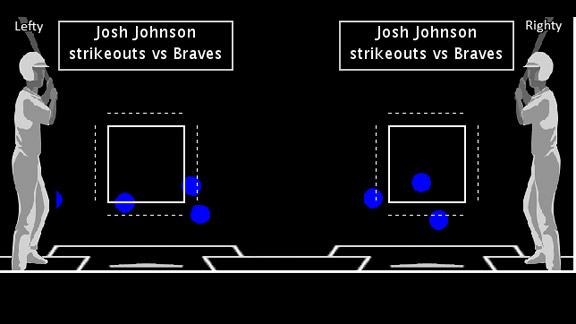Marlins starter Josh Johnson may have only lasted six innings due to a cut on his hand, but this was the vintage version of Johnson that beat the Braves on Monday.
Johnson struck out nine and walked none in his six innings of one-hit ball, the first pitcher to do the one-hit, nine-whiff, no-walk combination in no more than six innings since Jordan Zimmermann for the Washington Nationals two seasons ago.
Johnson had his best breaking ball in this start. Braves hitters missed on 12 of their 18 swings against his breaking pitches.
But this was nothing new. Johnson struck out seven Braves with the combination of his curve and slider, the third straight start against the Braves in which he’s done that.
The key to the success of that pitch was its location. Of Johnson’s 36 breaking balls, our pitch-performance tracking tool noted 31 as being in the lower-third of the strike zone or below. The image atop this story shows the location of Johnson's breaking pitches that notched strikeouts.
Johnson had allowed at least one hit with the breaking ball in each of his last six starts, and yielded a homer with it in each of his previous two.
Some in the stat community feel that Johnson will improve in the second half of the season because his combination of strikeouts, walks and home runs is indicative of a pitcher with a lower ERA.
Entering the Monday start, Johnson’s FIP (an abbreviation for Fielding Independent Pitching, an ERA estimate based on that combination of numbers) was 3.13, far below his season-ERA of 4.35 entering Monday.
In fact, the 1.23 differential was the fourth-highest among pitchers who are currently qualified for the ERA title. The three higher are Jake Arrieta, Tim Lincecum, and Jon Lester.
Johnson also entered with the highest batting average on balls in play (BABIP) of any National League pitcher (.345), but Marlins defenders were able to turn nine of the 10 balls hit against him into outs.
Johnson struck out nine and walked none in his six innings of one-hit ball, the first pitcher to do the one-hit, nine-whiff, no-walk combination in no more than six innings since Jordan Zimmermann for the Washington Nationals two seasons ago.
Johnson had his best breaking ball in this start. Braves hitters missed on 12 of their 18 swings against his breaking pitches.
But this was nothing new. Johnson struck out seven Braves with the combination of his curve and slider, the third straight start against the Braves in which he’s done that.
The key to the success of that pitch was its location. Of Johnson’s 36 breaking balls, our pitch-performance tracking tool noted 31 as being in the lower-third of the strike zone or below. The image atop this story shows the location of Johnson's breaking pitches that notched strikeouts.
Johnson had allowed at least one hit with the breaking ball in each of his last six starts, and yielded a homer with it in each of his previous two.
Some in the stat community feel that Johnson will improve in the second half of the season because his combination of strikeouts, walks and home runs is indicative of a pitcher with a lower ERA.
Entering the Monday start, Johnson’s FIP (an abbreviation for Fielding Independent Pitching, an ERA estimate based on that combination of numbers) was 3.13, far below his season-ERA of 4.35 entering Monday.
In fact, the 1.23 differential was the fourth-highest among pitchers who are currently qualified for the ERA title. The three higher are Jake Arrieta, Tim Lincecum, and Jon Lester.
Johnson also entered with the highest batting average on balls in play (BABIP) of any National League pitcher (.345), but Marlins defenders were able to turn nine of the 10 balls hit against him into outs.

http://espn.go.com/blog/statsinfo/po...-johnsons-hook


Comment